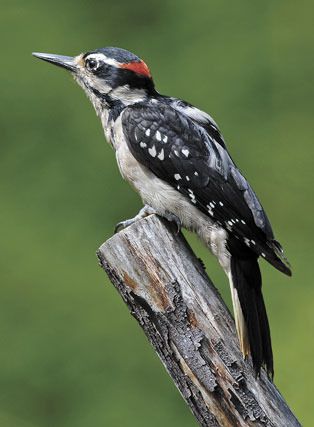A sharp pounding on the metal downspout outside my window practically rattles my teeth. It’s a northern flicker using this hollow sounding board to communicate with other flickers.
A loud rapid, “wuk, wuk, wuk, wuk, wuk,” draws my eyes to a Douglas fir tree where a large black and white pileated woodpecker clings to the side of the trunk. A return vocalization announces the arrival of its mate.
Both downy and hairy woodpeckers trade-off trips from the blooming magnolia tree to the suet feeders hanging outside my window. At times they get closer in sync and will land at the same time, one on one feeder the other on a second feeder. These small, black and white, look-alike woodpecker species frequent our garden year round. The males sport a red swatch across the back of the head.
If I walk part way down my driveway to a tall poplar tree, I might see a red-breasted sapsucker. They cling to the trunk monitoring sap wells, producing even rows of small holes drilled into the trunks to access the sap. Not surprisingly, a group of sapsuckers is collectively known as a “slurp” of sapsuckers.
The wells also attract insects, which the sapsuckers lazily consume. Rufous hummingbirds may follow the sapsucker around feeding from the same wells.
Pretty amazing. All five of our local woodpeckers can be seen within a stone’s throw of my home office.
For the last 14 years, my husband and I have tried to balance our needs with what we know will attract the birds. Our trick? We take the easy path and pretty much let nature alone to offer up the best habitat.
Large, old maple and alder trees grow in the ravine next to our house, some with dead and decaying trunks and branches. Several of those trees are riddled with woodpecker holes and one snag has been so popular with woodpeckers it looks like Swiss cheese.
I’m convinced that pileated woodpeckers use that tree either for nesting or for roosting at night. The rectangular holes are one clue, but also the fact that these birds may dig out a dozen entrance holes in one hollow tree to give them escape options should a predator enter their abode.
When we must remove trees, we try to leave stumps, which will decay and become favorite feeding places for the woodpeckers. Our lawn is free of chemicals and the flickers probe through it for insects.
I recently learned that ants make up 80 percent of the flicker’s diet. I gleaned this information from a charming new picture book recently published by Craig and Joy Johnson. “Harry the Woodpecker’s Search for a Home” is delightful for any age and features Craig’s watercolor illustrations. Plus it’s chock full of woodpecker information.
I also learned from the Johnsons’ book that a pileated woodpecker may strike a wood surface with its bill about 12,000 times a day. In addition to looking for food and creating cavities, the tapping communicates with other woodpeckers.
Other birds may sing to attract a mate and identify territory. Woodpeckers spread the word about their breeding needs by pounding on hollow trees, metal chimneys and gutters, like that flicker drumming on my downspout. The louder the sound, the better.
Usually this noise is short-lived and stops after the flickers pair up and settle into new nesting territories. Check out the Johnsons’ books (available at local bookstores) for ways to create woodpecker habitat in your garden or local park.
Frances Wood can be reached at wood@whidbey.com and Craig Johnson is at Craigjohnson@whidbey.com


